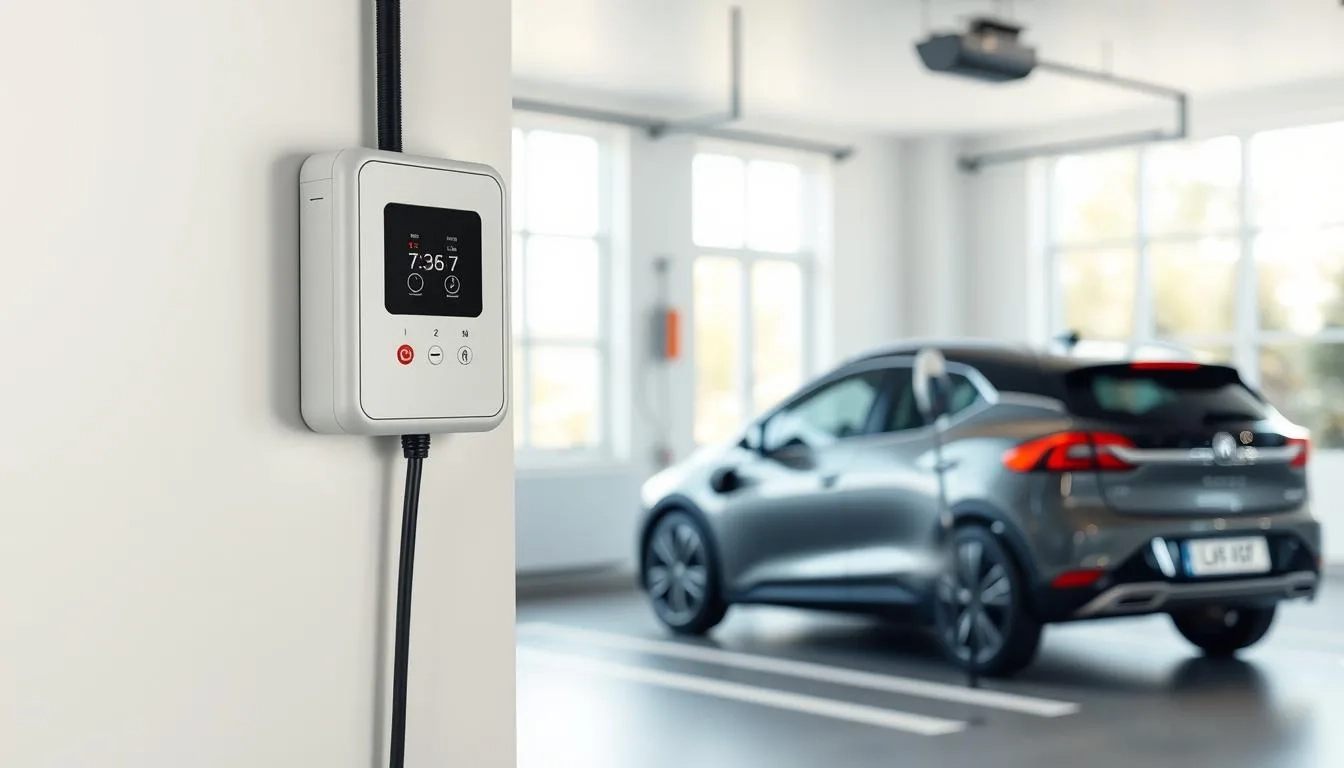The move towards electric vehicles is driving up demand for EV charging stations, mainly in homes. In 2022, over 800,000 electric cars were sold in the U.S. This number is expected to nearly double in 2023 thanks to federal tax credits. Homeowners are now looking to install charging solutions in their garages.
They prefer charging at home over public spots, which are getting crowded. By 2023, only a small part of public charging ports are Level 1. Most are Level 2, giving about 25 miles of range per hour. So, having a good charging station in the garage is not just convenient. It also prepares homeowners for the future of electric vehicle charging.
Understanding EV Charging Stations
EV charging solutions are key for electric vehicles to recharge. They are found in homes, workplaces, and public areas. Knowing about Level 1, Level 2, and DC Fast Chargers helps EV owners pick the right one.
Level 1 chargers use standard 120V outlets and charge slowly. They can charge a BEV in 22-40 hours. This means a car can get 3-7 miles of range per hour of charging. They are mostly used at home.
Level 2 chargers are faster, using 240V and charging up to 19.2 kW. They can give 10-75 miles of range in one hour. This makes them a favorite for both home and work charging.
DC Fast Chargers are the fastest, with power from 50 kW to 350 kW. Most BEVs can charge in 15-45 minutes. They’re great for long trips and are found near highways.
As EV charging tech grows, knowing about different charging options is key. It makes driving electric more convenient and meets the growing demand for EVs.
The Benefits of Having an EV Charger at Home
Having an EV charger at home saves a lot of money compared to public charging stations. Most EV owners charge their cars overnight. This takes advantage of lower electricity rates, making it cheaper.
For example, charging a 54 kWh battery fully costs about $6 at ¢10.7 per kWh. This works out to just $0.03 per mile. It’s a big cost savings.
Charging your car at home is super convenient. You can use AC Level 1 or AC Level 2 chargers. Level 1 is great if you have a dedicated outlet, and it’s free.
Level 2 chargers are better for longer drives or bigger batteries. They charge faster than Level 1.
Home charging means no long waits or empty spots like at public stations. Plus, homes with EV chargers might sell for more. As more people switch to electric cars, having a charger at home gets even more appealing.
How to Choose the Right EV Charger for Your Home
Choosing the right EV charger for your home means understanding the difference between Level 1 and Level 2 chargers. Level 1 chargers come with most electric vehicles and charge slowly. They add about 3-5 miles of range per hour. This is good for drivers who don’t travel much.
On the other hand, Level 2 chargers charge faster. They add 20 to 40 miles of charge per hour. This is better for drivers who travel more.
When looking at EV chargers, think about how fast they charge and if they work with your car. For example, the Emporia Level 2 EV Charger charges up to 48 A. This means a full charge in five to eight hours. It also comes with a 24-foot cord for easier installation.
The United Chargers Grizzl-E Classic can charge up to 40 A. It charges a battery in six to nine hours. It has a strong 25-foot cord and costs $350.
If you have more than one electric vehicle, the Grizzl-E Duo can charge two at once. But it charges slower. The Lectron Portable Level 2 Charger is great for those who need to move it around. It supports up to 40 A and costs $260 for the J1772 version.
Remember, you also need to think about installation costs, which can be between $500 and $2,000. By looking at these features, you can pick an EV charger that fits your needs and budget.
Installation of EV Charging Stations
Installing an EV charger at home requires checking your property’s electrical setup. You also need to follow local EV charging rules. It’s best to hire skilled electricians for this job to make sure it’s done right.
These experts will look at your electrical system, see if upgrades are needed, and install the charger. They make sure everything works safely and well.
The cost to install EV chargers varies a lot. For Level 1 chargers, it can be between $400 and $1,500. Level 2 chargers cost more, with an average of $1,300 for installation.
Other things like upgrading your electrical panel or how far the charger is from the panel can also affect the price.
It’s important to know the local rules for EV charging. Some places have rules about signs, permits, and what equipment you can use. Talking to local Clean Cities coalitions can help you understand these rules.
The complexity of the job can also raise the cost. Labor is usually the biggest part of the expense.
There are ways to make the cost more manageable. The 30C Tax Credit can help by covering up to 30% of the installation cost. As more people start using electric vehicles, having a well-installed EV charger can add value and convenience to your home.
The Role of Renewable Energy in Charging
Renewable energy, like solar power, is key for charging electric vehicles (EVs). Homeowners can use solar power to cut down on fossil fuels. This makes energy cleaner and reduces carbon emissions from EVs.
Putting solar panels on homes lets people make their own clean energy. This way, they can charge their cars with sunlight. It’s cheaper and better for the planet.
Charging EVs with solar power helps cities breathe easier. EVs pollute less than gas cars, making cities cleaner. Smart charging systems also save money by adjusting to energy prices.
When homes charge EVs with solar power, it helps the grid too. It makes energy use more reliable and green. The future of EV charging is all about using more renewable energy.
State Incentives and Rebates for EV Charging Stations
Homeowners looking to install EV charging stations can find help with costs. Federal programs offer tax credits that can cover up to 30% of the cost, up to $1,000. These credits usually range from $300 to $800 for those who qualify.
To get these tax benefits, you must meet certain criteria. This includes living in non-urban or low-income areas. You’ll need to use IRS Form 8911 to claim the Alternative Fuel Infrastructure Tax Credit. This form lets you manage tax credits over time.
State governments also offer rebates for installing chargers at home. Some states even give incentives for chargers in multi-family buildings. You can find local programs by using the Database of State Incentives for Renewable Energy (DSIRE) with your zip code.
Utility companies often provide rebates or special programs for new installations. For example, they might give cash for charging during peak times. The FY25 EVSE Rebate Program has $2.5 million for these efforts, with $1.5 million for homes and $1.0 million for businesses. Home rebates can cover 50% of costs, up to $700.

Homeowners should act fast due to recent changes. Funding for these programs has run out, and rebates for Level 1 EVSE are no longer available after October 1, 2023. Applications are processed first-come, first-served until all funds are gone. More funding might be available for unprocessed apps after April 1, 2025.
The Maryland Energy Administration (MEA) is looking into more benefits for EVSE in certain areas. Keeping up with these updates can help save money when installing an EV charging station at home.
Overcoming Common Misconceptions About EV Charging
Many people worry about EV charging myths, which hold them back from getting electric cars. One big worry is range anxiety, or not having enough battery power for daily trips. But, most electric cars, like the Tesla Model 3 and Hyundai Ioniq 6, can go about 300 miles on one charge.
Using a home charging station means you can start each day with a full battery. This makes it easier to deal with range anxiety.
Another myth is that charging takes too long. But, with Level 2 and Level 3 (DC fast) chargers, charging is much faster. Level 3 chargers can give an 80% charge in just 20-30 minutes. This makes electric cars more practical for quick trips.
Telling people about these fast-charging options can help them feel more confident about electric cars.
Businesses can also help by installing EV chargers. This attracts eco-friendly customers and can make money through charging fees. Companies that add EV chargers show they care about the planet. This makes employees happier and more loyal to the brand.
By tackling these myths, we can get more people to use electric cars. This supports our environment and improves the EV charging system.
Future Trends in EV Charging Stations
The future of EV charging looks bright, with ultra-fast charging stations becoming more common. These stations can charge an EV in under 30 minutes. This makes owning an electric car more appealing because it’s faster and more convenient.
In Q2 of 2024, the number of EV charging ports grew by 6.3%. DC fast charging ports saw a 7.4% increase. California leads with the most public charging ports.
Smart charging technology is key to this progress. It lets cars charge when electricity is cheapest and the grid isn’t too busy. This tech helps use energy better, making life easier for users and the grid healthier.
Power management systems play a big role. They balance loads, making charging more efficient. This can save money by avoiding the need for expensive upgrades.
Many homes and businesses can’t handle multiple charging stations at once. But smart tech can boost energy capacity. This makes it easier to add more stations in the future without huge costs.
Vehicle-to-grid (V2G) technology shows how EVs can help the grid. They can stabilize it during busy times and support renewable energy.
Wireless EV charging is starting to take shape, with global standards being set. Public money is going into electric buses, showing a big commitment to EVs. EV roaming is getting better, making it easier to charge on the go. This reduces worries about running out of charge and makes electric cars more attractive.
The Impact of EV Charging on Property Value
Adding an EV charging station can really boost your property’s value. It’s a big plus for anyone looking to buy a home. Studies show homes near EV charging spots see their value go up by about 3.3%.
This means they could sell for an extra $17,212. The biggest jumps happen when homes are just 0.4 to 0.5 kilometers away. In these cases, property values can soar by 5.8%.
Having eco-friendly features is key for buyers who care about the planet. EV charging stations make homes more attractive. They show that a house is part of a green living movement.

As electric cars become more popular, homes with charging stations will likely be worth more. This makes EV charging a smart investment for homeowners. It helps them stand out in a competitive market, showing they’re committed to eco-friendly living.
Building a Community of EV Users
Electric vehicles (EVs) are becoming more popular, and building a community around them is key. With over 1 million EVs on U.S. roads, this community is a place to share experiences. It helps with finding charging spots, which is crucial as EV numbers are expected to rise to over 26 million by 2030.
Being part of EV owner forums offers great advice on charging and maintenance. It also helps in pushing for more charging spots. This is important since many homes don’t have a dedicated spot for charging.
Grassroots efforts in the EV community can really help. They raise awareness and support for EVs. As charging tech improves and more spots are built, we’re moving towards a greener future for electric cars in the U.S.













